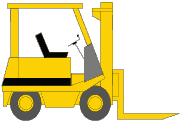Forklift "BUZZ" Words
SRO/SRN:
Basically designed as a safety feature, it requires the operator to return
the directional lever to neutral anytime the seat or key switch is opened. The letters stand for Static Return
to Off, or Neutral. To allow for momentary openings of the seat switch, if a bump is encountered, a built in time
delay of 1/2 to 2 seconds is used on most systems.
PMT:
Another safety feature, called Pulse Monitor Trip. This feature monitors the
length of the #1 REC or Main SCR "ON" time. If the #1 REC remains on for too long a period of time or
is shorted, the control system will trip or drop out the directional contactors. If, of course, the #1 REC is shorted
or not being turned off properly the vehicle will go directly to full speed (without passing GO) without control,
a dangerous condition without a PMT circuit. This feature is also used on many of the transistorized systems. In
a Transistorized system the PMT circuit will monitor the "ON" time of the main transistors or FETs (Field
Effect Transistor). High Pedal Protection/Accelerator Volts Hold-Off: This safety feature has many names including
neutral start, high pedal disable or simply Hi-Pot. Circuitry within the controller monitors the actual accelerator
pedal position and disables the control from starting if the accelerator pedal is depressed in any way. Hi-Pot
protects against sudden starts caused by problems in the accelerator linkage or potentiometer itself. If the accelerator
is depressed at start-up it must be released completely to a resting position before the controller will activate.
This feature may cause problems when the accelerator is slightly out of adjustment. On General Electric systems
incorporating this feature, the accelerator voltage must be a minimum of 2.5 volts or the system will not operate.
Emergency Reversal Circuit:
Obviously designed for emergency conditions, mainly found in the newer Mosfet
Control Systems. This feature is activated by a "belly button" switch to immediately reverse the vehicle
when necessary. Each system varies considerably on how this function operates.
Electronic "BUZZ" Words
VOLTAGE:
Electrical pressure which causes current to flow through an electric circuit.
Voltage is measured across the various components in any system. As an example; if we placed a volt meter across
a 36 volt contactor coil we will measure the actual voltage drop across that coil, in this case we should measure
36 volts, when the coil is energized.
CURRENT:
The movement of electrons through a conductor or complete electrical circuit. Current
flow is created by the voltage force placed on the circuit. Current is measured in amperes. To measure current
you must place a current meter in series with the circuit you are measuring. As an example; if you wish to measure
the current flowing through a 36 volt coil you must first disconnect one end of the coil, then connect one lead
of the current meter to the wire which you disconnected from the coil, and the other lead to the coil itself. Your
measurement will depend on the coil parameters and the voltage rating. A typical current reading for a 36 volt
coil would be aprox 1.5 amps.
RESISTANCE:
That property of a substance which impedes current and results in the dissipation
of power in the form of heat (boy, that's a mouthful). All components in any circuit will have some resistance,
including the heavy power cables in a forklift. A faulty or loose connection will create more and more resistance
as the current through the connection increases. As the resistance increases, so will the heat at the faulty area.
Resistance is measured in ohms.
CIRCUIT:
An electronic path between two or more points for the purposes of carrying electrical
current. In order to have a complete circuit you must have a power source, some form of resistance (to limit the
amount of current) and complete connections between all the components.
SERIES CIRCUIT:
A circuit in which resistances or other components are connected end to end
so that the same current flows throughout the circuit.
PARALLEL CIRCUIT:
A circuit in which all positive terminals are connected to a common point,
and all negative terminals are connected to a second common point. The voltage is the same across each element
in the circuit. The current is split between all parallel paths and may be different in each path, depending upon
the resistance in that particular path.

BE SURE TO VISIT THE HOME PAGE
FOR INFORMATION ON LIFT TRUCKS REPAIR, SERVICE, TROUBLESHOOTING, AND EVERYTHING YOU NEED TO KNOW ABOUT FORKLIFTS
AND THEIR USE.
 --BACK TO HOME PAGE.
--BACK TO HOME PAGE.

